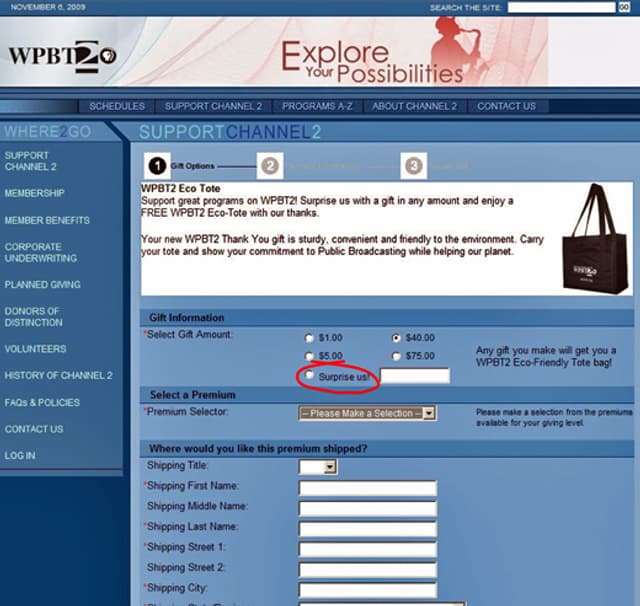McPherson Associates/WPBT2: the ‘surprise us’ tick box
- Exhibited by
- Tim Oleary, McPherson Associates, Malvern, PA, USA.
- Added
- June 20, 2011
- Medium of Communication
- Direct mail
- Target Audience
- Individuals, regular gift, single gift
- Type of Charity
- Country of Origin
- USA
- Date of first appearance
- 2009
Creator / originator
Jennifer Gibbs, Vice President of Development at WPBT2 really put the wheels in motion on this once we talked about it.
Summary / objectives
This idea came about by accident, as Tim Oleary explains.
Background
McPherson Associates originally started the idea of 'surprise us' with our client WPBT2, the public television station for South Florida. WPBT2 typically ranks as one of the 10 most-watched public television stations in the US with an audience of more than one million households watching per week. They have approximately 38,000 active donors. The 'surprise us' initiative came about during a discussion about an approach to a lapsed segment they were not really reaching out to very often. I suggested that we should not have high expectations for the response from this group and would be happy if they just 'surprised us' by making a gift. We decided right there and then that 'surprise us' should be an ask amount. WPBT2 and most of the 16 public stations we work with now use 'surprise us' on the reply cards for additional gift appeals, lapsed mailings and even some renewals. We also have used this with success on online giving forms. With most of these organisations they use 'last gift amount' as a driver for the gift matrix and typically add a percentage onto it for ask 2. Donors were responding by writing in their own amount, typically giving in between ask 1 and ask 2. So they wanted to help a little more, but maybe didn't think they could stretch all the way to ask 2 or, God forbid, the much higher ask 3.
Special characteristics
Most stations will use 'last gift amount' as ask 1, and then use 'last gift amount + 50 per cent' as ask 2. Then there are a few who think they can trick the donor into giving more money by going with 'last gift amount +100 per cent', as an ask 3. It's an awful practice and we discourage it when we can, but ultimately some insist on this tactic. So if my last gift was $50, my ask string may look like $50, $75, $100 instead of just $50, $75. Where we have seen the most success with 'surprise us' is in the latter scenario where most donors are selecting an amount between the two.
Influence / impact
Leading Canadian environmental organisation Ontario Nature is one organisation that is about to try this (see reply form, below). Watch this space for results.
Results
The results were surprisingly good. The average gift increased by 15-20 per cent and response rates remained the same.
Merits
It is a simple and easily shareable idea. And it works.
Other relevant information
McPherson Associates founder Richard McPherson wrote about this initiative recently in his blog. Here are some highlights: 'President Obama strikes a deep chord when he tells us we have to re-invent our power grid, health care and schools. There's no reason to think nonprofit business methods – including donation pricing – should be any different. Studying shifting average donation amounts and successful tests of deeply “discounted" donation levels, our clients decided to try their own “stimulus" programme. They dumped the very common “other" category on their mail appeals and substituted “surprise us!" The results were surprisingly good. The average gift increased by 15-20 per cent and response rates remained the same. We have seen organisations test “you pick it", "my gift for scholarships" and a variety of alternatives to “other". In no case did it hurt results and in many cases it helped – sometimes a lot. Many organisations were surprised by both the size and the large number of donations they received when people were encouraged to think up their own amount. It may have to do with the simple act of being in charge, feeling good about helping and being asked to support our work – instead of being asked to tick a box for our database. Trillions of dollars have vanished from donors' 401(k) accounts, several Fortune 500 companies are now virtually penny stocks – and it's almost tax time again. It seems a tad insensitive to tell people how much to give. Yes, yes, I know all about testing and control packages, but worry that both are increasingly suspect concepts in a long-term economic crisis. 'Our findings are also a reminder that words matter. It turns out Mark Twain was right when he said, “The difference between the right word and the almost right word is the difference between lightning and the lightning bug." Let me know what words you're using to help donors give.'

 View original image
View original image

Also in Categories
-
Tags
- Tick box

















